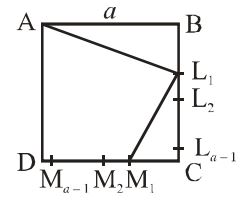1. Let $${{{b}}_{{i}}} > 1{\text{ for }} i = 1,2,....,101.$$ Suppose $${\log _e}{{{b}}_1},{\log _e}{{{b}}_2},.....,{\log _e}{{{b}}_{101}}$$ are in Arithmetic Progression (A.P.) with the common difference $${\log _e}2$$. Suppose $${{{a}}_1},{{{a}}_2},.....{{,}}{{{a}}_{101}}$$ are in A.P. such that $${{{a}}_1} = {{{b}}_1}$$ and $${{{a}}_{51}} = {{{b}}_{51}}$$ . If $${{t}} = {{{b}}_1} + {{{b}}_2} + ..... + {{{b}}_{51}}$$ and $${{s}} = {{{a}}_1} + {{{a}}_2} + ..... + {{{a}}_{51}},$$ then
A.
$${{s}} > t {\text{ and }}{{{a}}_{101}} > {{{b}}_{101}}$$
B.
$${{s}} > t {\text{ and }}{{{a}}_{101}} < {{{b}}_{101}}$$
C.
$${{s}} < t {\text{ and }}{{{a}}_{101}} > {{{b}}_{101}}$$
D.
$${{s}} < t {\text{ and }}{{{a}}_{101}} < {{{b}}_{101}}$$
Answer :
$${{s}} > t {\text{ and }}{{{a}}_{101}} < {{{b}}_{101}}$$
2. Let $$x, y, z$$ be three positive prime numbers. The progression in which $$\sqrt x ,\sqrt y ,\sqrt z $$ can be three terms (not necessarily consecutive) is
A.
A.P.
B.
G.P.
C.
H.P.
D.
none of these
Answer :
none of these
3. In a, G.P. of $$3n$$ terms, $$S_1$$ denotes the sum of first $$n$$ terms, $$S_2$$ the sum of the second block of $$n$$ terms and $$S_3$$ the sum of last $$n$$ terms. Then $$S_1, S_2, S_3$$ are in
A.
A.P.
B.
G.P.
C.
H.P.
D.
None of these
Answer :
G.P.
4. If the $${2^{nd}},{5^{th}}$$ and $${9^{th}}$$ terms of a non-constant A.P. are in G.P., then the common ratio of this G.P. is:
A.
$$1$$
B.
$$\frac{7}{4}$$
C.
$$\frac{8}{5}$$
D.
$$\frac{4}{3}$$
Answer :
$$\frac{4}{3}$$
5. Sum of infinite number of terms of G.P. is 20 and sum of their square is 100. The common ratio of G.P. is
A.
5
B.
$$\frac{3}{5}$$
C.
$$\frac{8}{5}$$
D.
$$\frac{1}{5}$$
Answer :
$$\frac{3}{5}$$
6. $$ABCD$$ is a square of lengths $$a,a \in N,a > 1.$$ Let $${L_1},{L_2},{L_3},.....$$ be points $$BC$$ such that $$B{L_1} = {L_1}{L_2} = {L_2}{L_3} = ..... = 1$$ and $${M_1},{M_2},{M_3},.....$$ be points on $$CD$$ such that $$C{M_1} = {M_1}{M_2} = {M_2}{M_3} = ..... = 1.$$ Then, $$\sum\limits_{n = 1}^{a - 1} {\left( {AL_n^2 + {L_n}M_n^2} \right)} $$ is equal to
A.
$$\frac{1}{2}a{\left( {a - 1} \right)^2}$$
B.
$$\frac{1}{2}a\left( {a - 1} \right)\left( {4a - 1} \right)$$
C.
$$\frac{1}{2}\left( {a - 1} \right)\left( {2a - 1} \right)\left( {4a - 1} \right)$$
D.
None of these
Answer :
$$\frac{1}{2}a\left( {a - 1} \right)\left( {4a - 1} \right)$$
7. If $${t_n}$$ denotes the $${n^{th}}$$ term of the series $$2 + 3 + 6 + 11 + 18 + .....\,$$ then $${t_{50}}$$ is
A.
$${49^2} - 1$$
B.
$${49^2}$$
C.
$${50^2} + 1$$
D.
$${49^2} + 2$$
Answer :
$${49^2} + 2$$
8. Three positive numbers form an increasing G.P. If the middle term in this G.P. is doubled, the new numbers are in A.P. then the common ratio of the G.P. is:
A.
$$2 - \sqrt 3 $$
B.
$$2 + \sqrt 3 $$
C.
$$\sqrt 2 + \sqrt 3 $$
D.
$$3 + \sqrt 2 $$
Answer :
$$2 + \sqrt 3 $$
9. The fourth term of an A.P. is three times of the first term and the seventh term exceeds the twice of the third term by one, then the common difference of the progression is
A.
$$2$$
B.
$$3$$
C.
$$\frac{3}{2}$$
D.
$$- 1$$
Answer :
$$2$$
10. Let $$\alpha {\mkern 1mu} {\text{,}}{\mkern 1mu} \beta $$ be the roots of $${x^2} - x + p = 0\,$$ and $$\gamma ,\delta $$ be the roots of $${x^2} - 4x + q = 0.\,$$ If $$\alpha {\mkern 1mu} ,{\mkern 1mu} \beta {\mkern 1mu} ,{\mkern 1mu} \gamma ,{\mkern 1mu} \delta $$ are in G.P., then the integral values of $$p$$ and $$q$$ respectively, are
A.
$$- 2, - 32$$
B.
$$- 2, 3$$
C.
$$- 6, 3$$
D.
$$- 6, - 32$$
Answer :
$$- 2, - 32$$
